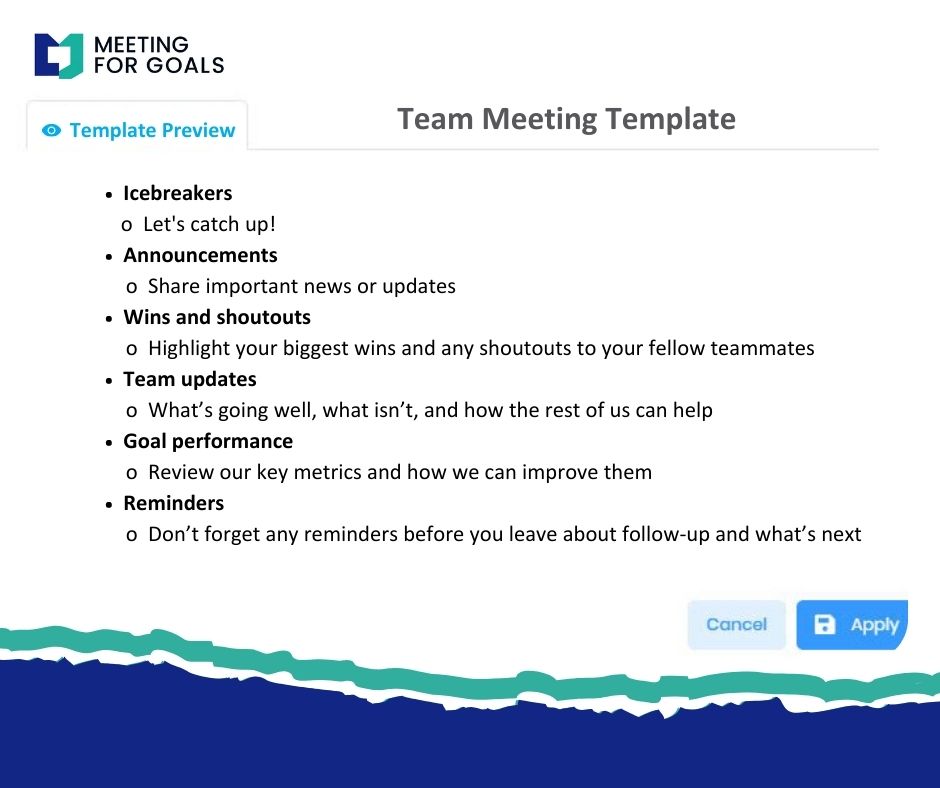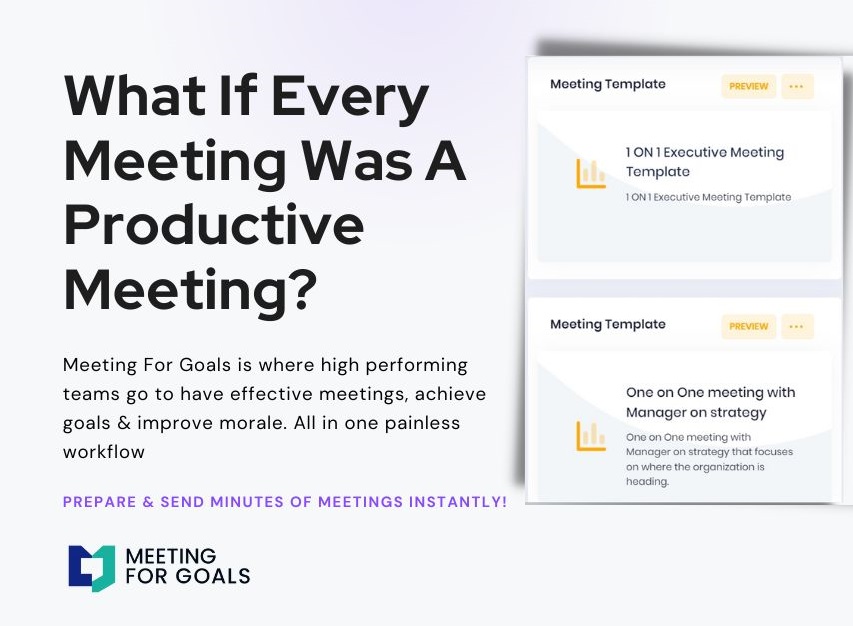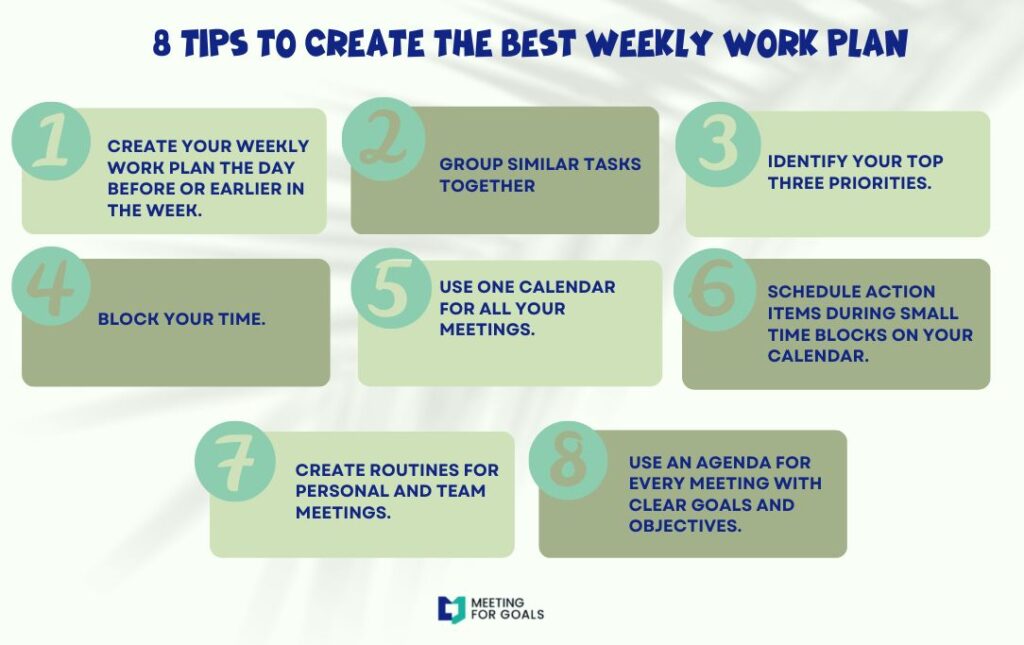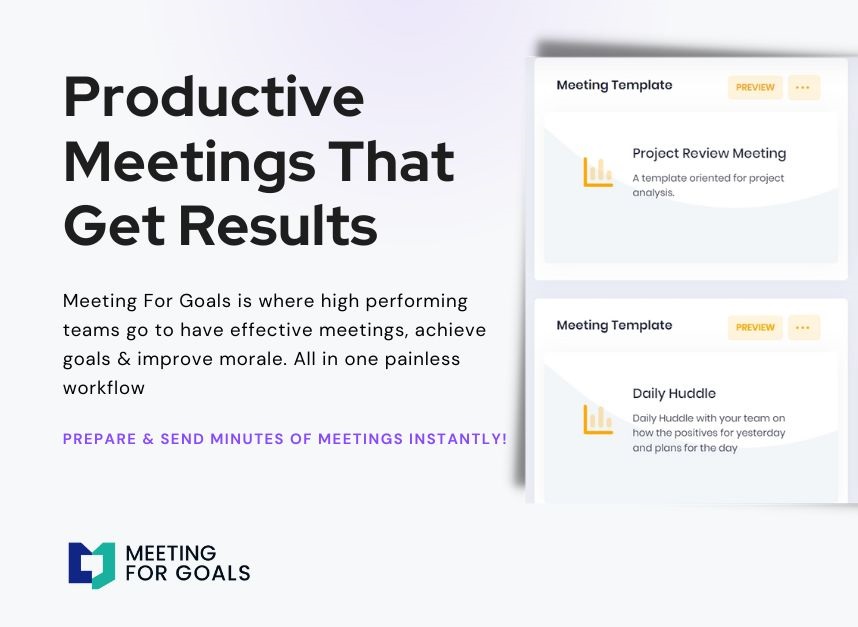Maximizing Productivity with Effective Team Meetings
In today’s fast-paced work environment, time is one of the most valuable resources. Yet, many teams waste countless hours in meetings that go nowhere. For executives managing teams of 40 to 70 employees, the cost of ineffective meetings is even higher. Efficient team meetings aren’t just helpful—they’re essential. They drive alignment, accountability, and performance. In this article, we’ll show you how to turn your meetings into productivity powerhouses using proven strategies and tools like Meeting For Goals. Learn how to make every minute count and transform your meetings into a competitive advantage.
Team meetings are a vital part of any successful organization. However, many meetings feel like a waste of time. They drag on, lack focus, and often end without clear outcomes. For leaders managing mid-sized teams, these inefficiencies can snowball into serious performance issues.
If your team is growing and you’re juggling multiple departments or projects, the challenge becomes even greater. Staying aligned, communicating effectively, and holding people accountable becomes harder with scale.
That’s where Meeting For Goals comes in. This meeting management software was built for leaders who want to cut the fluff and focus on results. It streamlines every step of the meeting process—from scheduling and agenda creation to follow-up and accountability tracking.
Whether you’re a VP, Director, or C-suite executive, this guide will give you the tools and strategies to:
- Define the true purpose of your meetings
- Plan and schedule meetings that respect everyone’s time
- Run meetings that are focused, engaging, and productive
- Follow up with clear accountability and action
If you’re ready to make your meetings actually matter, you’re in the right place.
👉 Ready to level up your meetings now? Sign up for Meeting For Goals today and get started: https://app.meetingforgoals.com/TenantRegistration/Register
2 Minute Video
Watch a 2 minute demo of our meeting management software in action
The Purpose of Team Meetings
Let’s start with the basics: why are you meeting in the first place?
Too often, meetings are scheduled just because “we’ve always had a Monday meeting.” But without a clear purpose, meetings become time drains instead of value drivers.
At their core, effective team meetings serve three main purposes:
- Communication
- Alignment
- Problem-solving
Communication is the foundation of any team. Meetings give people a platform to share updates, raise concerns, and clarify expectations. When communication breaks down, so does collaboration.
Alignment is equally important—especially for teams with 40 to 70 people. It’s easy for departments to become siloed. Regular meetings help everyone stay on the same page and ensure that individual efforts support broader company goals.
Then there’s problem-solving. Meetings should be a space where teams come together to brainstorm, troubleshoot, and make decisions. However, this only happens when meetings are structured to encourage participation and focus on outcomes.
A clear meeting purpose helps everyone show up prepared and engaged. It sets the tone and keeps the conversation productive.
Meeting For Goals makes this easy by allowing you to define and document the purpose of each meeting in the platform. You can even link your meeting objectives directly to company goals. This means every meeting has a reason—and a result.
Still not sure what your meeting should accomplish? Check out our free meeting templates for inspiration: https://meetingforgoals.com/meeting_templates
When meetings are intentional, they become a tool for progress—not a hurdle.
Adding an Agenda
How to add an agenda instantly on Meeting For Goals
Best Practices for Scheduling and Planning Meetings
Planning may not be glamorous, but it’s where great meetings begin.
The first step? Choose the right time. Avoid scheduling meetings when people are least focused—like early Monday mornings or late Friday afternoons. Instead, use team feedback or scheduling tools to find time slots when most people are available and alert.
Shorter meetings are usually better. Aim for 30 to 45 minutes. If you need more time, break the meeting into parts or schedule a follow-up.
Next, craft a clear agenda. This is your roadmap. It should include:
- The meeting’s goal
- Key topics to discuss
- Who’s presenting each topic
- How much time is allocated per item
Share the agenda at least 24 hours in advance. This gives your team time to prepare and keeps the meeting focused.
Meeting For Goals simplifies this with built-in agenda templates and calendar integrations. You can create and share agendas in minutes—and avoid double-booking with smart scheduling features.
Another tip: Be selective about who attends. Not everyone needs to be in every meeting. Invite only the people who are directly involved. This keeps meetings lean and respectful of everyone’s time.
Also, define what a successful meeting looks like. Is it a decision made? A plan finalized? A problem solved? Knowing the desired outcome helps guide the conversation and keeps things on track.
For more tips on how to structure your meetings for success, visit our templates page: https://meetingforgoals.com/meeting_templates
In short, thoughtful planning turns meetings from chaos into clarity.
Techniques for Conducting Effective Meetings
So, you’ve scheduled the meeting and shared the agenda. Now it’s time to run it.
Start strong. Open the meeting by restating the purpose and the desired outcome. This helps set expectations and gets everyone mentally aligned.
Next, foster open communication. Encourage people to speak up—but keep the conversation focused. Use active listening techniques like paraphrasing or asking clarifying questions to show that you value input.
Assigning roles can also help. Consider these:
- Meeting Leader: Guides the discussion and keeps things moving
- Timekeeper: Keeps track of time for each agenda item
- Note-Taker: Captures key points, decisions, and action items
These roles ensure that the meeting stays on track and that nothing gets missed.
Stick to your agenda. If a topic runs over time, consider creating a “parking lot” to revisit it later. Don’t let one issue derail the entire meeting.
Meeting For Goals helps here, too. It offers real-time agenda tracking, role assignments, and integrated note-taking so you can stay organized and focused.
Keep engagement high with simple techniques like:
- Round-robin updates
- Quick polls or votes
- Visual aids like dashboards or slides
These keep the energy up and make the meeting more interactive.
End the meeting with a recap. Summarize the key takeaways, decisions made, and next steps. Ensure everyone knows what they’re responsible for and by when.
Want to see how this looks in action? Try one of our pre-built meeting templates: https://meetingforgoals.com/meeting_templates
Effective meetings don’t just happen—they’re led with purpose and structure.
Follow-Up and Accountability After Meetings
Here’s the truth: a meeting isn’t over when it ends.
The real impact comes from what happens next.
First, document everything. This includes:
- Key decisions
- Assigned tasks
- Deadlines
- Responsible team members
Meeting For Goals automates this process. It generates a meeting summary and action item list that you can send out immediately. No more scrambling to remember who said what.
Next, assign ownership. Every task should have a clear owner and deadline. This prevents things from slipping through the cracks.
Follow up regularly. Use one-on-ones or team check-ins to review progress. Meeting For Goals has built-in dashboards that make it easy to track action items and goal progress in real time.
Also, connect action items to company goals. This helps your team understand how their work contributes to the big picture. When people see the “why” behind their tasks, they’re more motivated to follow through.
Don’t forget to ask for feedback. What went well in the meeting? What could be improved? This creates a culture of continuous improvement and helps you refine your process over time.
One more tip: Celebrate wins. When a team follows through and hits a goal, take a moment to recognize it. It boosts morale and reinforces the value of effective meetings.
Looking for a tool to manage all of this in one place? Sign up for Meeting For Goals here: https://app.meetingforgoals.com/TenantRegistration/Register
Conclusion
Meetings don’t have to be a waste of time. In fact, when done right, they can be one of your most powerful tools for driving progress.
Here’s a quick recap of what we covered:
- Know the purpose of your meetings: communication, alignment, and problem-solving.
- Plan and schedule with intention: the right time, the right people, and a clear agenda.
- Run meetings with focus: assign roles, encourage engagement, and stick to the plan.
- Follow up with accountability: document actions, assign ownership, and track progress.
With the right strategies and tools, you can turn meetings into a strategic advantage for your team.
Meeting For Goals was built for leaders like you—those who want to drive real outcomes, not just talk about them. From agenda creation to follow-up tracking, it’s your all-in-one platform for effective team meetings.
👉 Ready to take your meetings to the next level? Sign up now: https://app.meetingforgoals.com/TenantRegistration/Register
Want to explore more ways to improve your team’s productivity? Visit our website for resources, templates, and expert insights: https://meetingforgoals.com
Because when meetings work, your whole organization works better.




